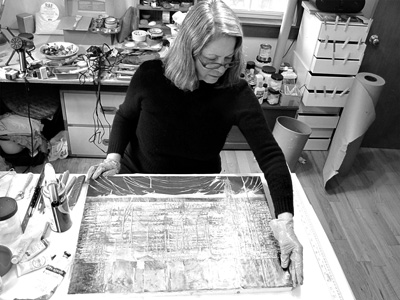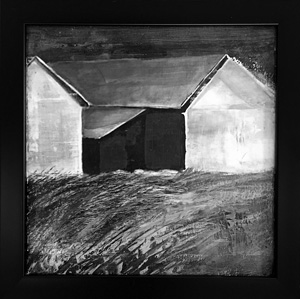Arts & Culture November 2017
Visible world, refracted through inner life
Vermont artist draws fans for abstract works with a sense of place
 The artist Dona Mara has built a loyal local following for her work since moving to Rupert, Vt., in 2003 and has participated in dozens of area shows in over the past decade. Courtesy photo /Steven Schlussel
The artist Dona Mara has built a loyal local following for her work since moving to Rupert, Vt., in 2003 and has participated in dozens of area shows in over the past decade. Courtesy photo /Steven Schlussel
By TELLY HALKIAS
Contributing writer
RUPERT, Vt.
When someone sits in a simple chair today, Dona Mara might see ancient royalty on a throne.
While a child munches away at an apple, Mara could imagine a sumptuous feast.
And if she were to drive by a weathered, collapsing country barn, Mara would dream of the day it was first raised -- bold and red against her beloved Green Mountains, with a sky so blue it would hurt to watch for too long.
But then it would be time to paint.
This is the world of the creative and the mind’s eye, one that the Rupert artist believes has always flourished inside her. It has given her an outlet to express her innermost sensibilities, and a way to welcome others into that sacred space, all while bucking her own doubts.
“Artists need an audience,” Mara said. “However, putting yourself out there to be judged, praised, criticized or ignored is a courageous act.”
This act, from her earliest days as one of six children growing up in upstate New York, was inexorably joined to her own self-evaluation as an introvert.
“I chose drawing, painting, and marking a surface, often feeling I didn’t have words for all I was feeling,” Mara explained.
But though Mara once may have felt challenged to express herself to others, she has, especially since she moved to Rupert in 2003, developed her art and built a loyal following of fans and collectors who find inspiration in her creations.
Mara admits to being hesitant to talk about herself much, choosing instead to speak mostly through the complexity of her art. But others, smitten with her work, have stepped up to speak for her.
One of her fans is Kathleen Achor of West Pawlet, a freelance editor who came to the realization that her yoga teacher and fellow book-group member was also the creator of several works of art she had purchased at local venues.
“I first became acquainted with Dona’s work when a stunning triptych of trees drew me into her booth at an arts festival,” Achor said. “She has rightly never sold this trio, keeping them together as they should be.”
But Mara has sold many other works, some of which add a distinct aesthetic to Achor’s home.
“Small pieces of Dona’s live in lived-in rooms in my house,” Achor said. “I see a Hokusai-inspired wave when I work out and can gaze upon an abstract pond if I do yoga. With a turn of my office chair, I can take a break from work and lose myself in the woods. A night forest bids me good night and good morning.”
Achor said she has a special affinity for two of Mara’s tree paintings, which bring her total personal inventory of Mara paintings to four. She described the tree paintings as forests that “manage to be at once abstract and very real, something that forests themselves are good at being.”
“Dona’s good at it too,” Achor added.
Mara’s ‘Barn Memories 2’ (2017) is an example of her recent work
 The artist of the family
The artist of the family
Mara’s resume includes dozens of shows over the past decade at venues as diverse as the Southern Vermont Arts Center in Manchester and McCartee’s Fine Art and Antiques in Salem, N.Y.
Mara said her recent paintings deal with planes of space that convey implied places of interest, beauty and wonder.
“Often a painting begins as I glimpse a particular textural field through a screened or rainy window,” Mara said.
She explained that her choices are guided by “a visceral desire to connect to nature” and that she learns to “change and flow through seasons with light, color, texture and form.”
The suggestion and ambiguity in a work without representation, she said, creates a sense of simplicity for which she strives.
“My continued hope is that the viewer is drawn into the work, finding a resting place or a human connection,” Mara said.
When she was growing up in the 1950s and ‘60s, Mara remembers that she was considered her family’s creative cog.
“Influences from the early period of my life, where I was ‘the artist’ in a large family, remain,” Mara said.
She said these include her “love of solitude” – something she prized even more amid the bustle and tumult of a large family – and the inspiration she draws from settings near water.
Mara said her youthful summer getaways to the Niagara River and the Great Lakes provided her with “new spatial relationships” and allowed her “to watch light on water, which delighted me.”
This appeal developed through more solitude at Stella Niagara Seminary in her younger years and later at Lewiston-Porter High School in Niagara County, where once again the artist label stuck to Mara well before her 1963 graduation.
Learning skills, pushing boundaries
Charles Bonenti, the longtime features editor of The Berkshire Eagle who retired in 2013, was a teenage friend of Mara’s who recently reconnected with her after four decades. He said he remembered her vision – and her ability to put together an exhibition.
“We were among a handful of creative types in the Niagara frontier town of Lewiston, New York, who hung out together during high school in the early 1960s,” Bonenti recalled.
The friends went off to different colleges after graduation, but Bonenti recalled how they all got together in the summer of 1964 to show their work at a seasonal art gallery they established in an old boathouse along the Niagara River.
“Although the venture was a commercial failure, I remember how skillful Dona was at foreshortening and painting human figures,” Bonenti said. “I still have a drawing she gave me.”
Mara earned a bachelor of fine arts degree in studio arts from Rochester Institute of Technology in 1967. After college, she worked as a graphic designer and illustrator.
She acknowledged that balancing a family, including raising two sons, with employment, art and graduate courses at Indiana State University, all took its toll on her personal life, which included marriage to the artist Alan Friedman until their divorce in 1989. But her study of art still provided lifelong inspiration.
“My teacher Charles Reddington and the artist in residence Michael Green became major influences for me as they encouraged experimenting and failing,” Mara said.
By encouraging her to move beyond her comfort level, these teachers “opened me to possibilities,” she added.
As Mara developed her creative and technical skills, she took turns working as a designer, manager of a plant nursery, real estate broker and teacher. In 1996, before moving to Vermont, she became co-owner of a store in Rockland County, N.Y., called Casa Verde Herbs, Books & Gifts with her then-partner and now husband, the photographer Steven Schlussel.
“These many chapters of my life show the truth of the statement that art is not a thing, it is a way,” Mara said.
Looking to the future, Mara said she has become intrigued by the idea of using digital media in her two-dimensional work. She said she is studying the editing of video and is exploring how to use it creatively with Schlussel, who she said continues to be “my emotional support and biggest fan.”
Seeking paths to the essence
Mara said her admiration for artists throughout history makes it difficult for her to single out a few as favorites. But she said that in recent times her interest in compositional space and detailed texture has been inspired by the works of others as diverse as the American painters Richard Diebenkorn, Pat Steir and Kiki Smith, the German artist Gerard Richter, the Ghanaian sculptor El Anatsui, and the 19th century Japanese artist Katsushika Hokusai.
“My early connection to textiles has returned in the exploring of surface texture in my recent work,” Mara said. “After painting in oils for many years, I discovered encaustic, which opened the door to new exploring.”
Encaustic is an ancient painting method that incorporates beeswax and damar resin as a heated medium for use in many ways. Most famously, Jasper John’s 1954 painting of the American flag, “Flag,” was done with encaustic.
“For my own work, this use of a thick, viscous medium with oils creates a surface that can be scratched into, revealing layers beneath,” Mara said.
The surface, she said, takes on “a luminous and mysterious depth” with an organic quality.
She said moving from representative oil painting to abstraction felt like a natural progression as she searched “for the essence and meaning in what I was seeing, seeking and saying.”
The result for Mara has been a series of abstract works that speak about a sense of place rather than any certain place.
She described exploring the Japanese principle of “shizen,” which involves striking a balance between being of nature yet distinct from it. The goal is to be viewed as being without pretense or artifice, while seeming intentional rather than accidental.
“Our complicated times regarding being human, living with and using nature, are questions I wrestle with,” Mara said.
But despite the artist’s struggles with weighty aesthetic questions, her fans and collectors say the essence of Dona Mara’s creations is pure love.
One effusive follower of Mara is Theresa Rebeck, an award-winning playwright, television writer and novelist who lives in Dorset part of the year.
Rebeck said she first saw Mara’s work at the Southern Vermont Arts Center’s annual group show.
“Dona had two small pieces which I just fell in love with, so I bought them on the spot,” Rebeck said. “Then I stalked her a bit. I found her at the Pawlet Art on the Green event one year and bought a piece there.”
Rebeck then sought out Mara’s work at the Equinox Village Gallery in Manchester, and the piece she bought there is now in her office.
And speaking perhaps for most owners of Mara’s art, Rebeck spoke of nothing but joy – a human connection of which the artist could approve.
“I love her spirit, her eye, her graceful intelligence,” Rebeck said. “I love finding her pieces in the corners of my house.”
For more information on the art of Dona Mara, visit dona-mara.com.
